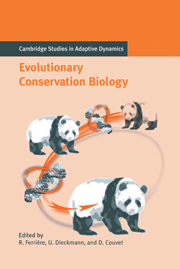Book contents
- Frontmatter
- Contents
- Contributing Authors
- Acknowledgments
- Notational Standards
- 1 Introduction
- Part A Theory of Extinction
- Part B The Pace of Adaptive Responses to Environmental Change
- Part C Genetic and Ecological Bases of Adaptive Responses
- Part D Spatial Structure
- Part E Community Structure
- References
- Index
- The International Institute for Applied Systems Analysis
1 - Introduction
Published online by Cambridge University Press: 15 August 2009
- Frontmatter
- Contents
- Contributing Authors
- Acknowledgments
- Notational Standards
- 1 Introduction
- Part A Theory of Extinction
- Part B The Pace of Adaptive Responses to Environmental Change
- Part C Genetic and Ecological Bases of Adaptive Responses
- Part D Spatial Structure
- Part E Community Structure
- References
- Index
- The International Institute for Applied Systems Analysis
Summary
Evolution has molded the past and paves the future of biodiversity. As anthropogenic damage to the Earth's biota spans unprecedented temporal and spatial scales, it has become urgent to tear down the traditional scientific barriers between conservation studies of populations, communities, and ecosystems from an evolutionary perspective. Acknowledgment that ecological and evolutionary processes closely interact is now mandatory for the development of management strategies aimed at the long-term conservation of biodiversity. The purpose of this book is to set the stage for an integrative approach to conservation biology that aims to manage species as well as ecological and evolutionary processes.
Human activities have brought the Earth to the brink of biotic crisis. Over the past decades, habitat destruction and fragmentation has been a major cause of population declines and extinctions. Famous examples include the destruction and serious degradation that have swept away over 75% of primary forests worldwide, about the same proportion of the mangrove forests of southern Asia, 98% or more of the dry forests of western Central America, and native grasslands and savannas across the USA. As human impact spreads and intensifies over the whole planet, conservation concerns evolve. Large-scale climatic changes have begun to endanger entire animal communities (Box 1.1). Amphibian populations, for example, have suffered widespread declines and extinctions in many parts of the world as a result of atmospheric change mediated through complex local ecological interactions. The time scale over which such biological consequences of global change unfolds is measured in decades to centuries.
- Type
- Chapter
- Information
- Evolutionary Conservation Biology , pp. 1 - 14Publisher: Cambridge University PressPrint publication year: 2004
- 8
- Cited by

